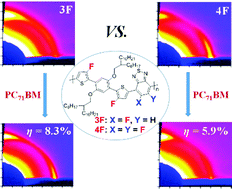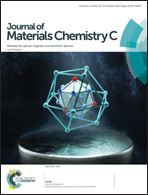Transforming the molecular orientation of crystalline lamellae by the degree of multi-fluorination within D–A copolymers and its effect on photovoltaic performance†
Abstract
Besides lowering the HOMO energy level of polymer donors to promote higher open circuit voltages (Voc) of polymer solar cells, fluorination of their conjugated backbones has been widely demonstrated to improve the overall device performance as well by inducing face-on orientated polymer crystalline lamellae, which is profitable for vertical charge transport. Nevertheless, over-fluorination (up to 4 fluorine atoms) causes severe solubility reduction and serious segregation, leading to large phase separation of PC71BM and subsequent low and unbalanced charge transport, thus deteriorating Jsc, FF and the overall PCE. The underlying impact of multi-fluorination of polymer donors on their interlinked optoelectronic and morphological properties thus remains beyond reach. Guaranteed with sufficient solubility, two D–A copolymers, poly[(5,5′-(2,5-bis((2-octyldodecyl)oxy)-1,4-phenylene)bis(4-fluorothiophene-5,2-diyl))-alt-((5-fluorobenzo[c][1,2,5]thiadiazole)-4,7-diyl)] (PDTBBT-3F) and poly[(5,5′-(2,5-bis((2-octyldodecyl)oxy)-1,4-phenylene)bis(4-fluorothiophene-5,2-diyl))-alt-((5,6-difluorobenzo[c][1,2,5]thiadiazole)-4,7-diyl)] (PDTBBT-4F) with 3 and 4 fluorine substituents on the same backbone, respectively, were therefore designed and synthesized. Although lower-lying HOMO energy levels and stronger intermolecular interactions were observed as before, more interestingly, the molecular packing of PDTBBT-3F and PDTBBT-4F in neat films was found to be diametrically opposite. PDTBBT-4F exhibits a preferred face-on orientation whereas the edge-on orientation is dominant for PDTBBT-3F. When mixed with PC71BM to form BHJ blends, the molecular orientation of PDTBBT-3F crystals was transferred to uniform edge-on/face-on intermixing with better crystallinity. Oppositely, the face-on oriented crystals were suppressed to be comparable with edge-on orientated ones with less crystallinity for PDTBBT-4F from the neat film to the BHJ blend. Such distinctive morphology improved the charge generation efficiency, balanced the charge transport and suppressed the charge recombination in the PDTBBT-3F:PC71BM device, eventually leading to an approximate 40% increase of the maximum power conversion efficiency (PCE, 8.33%) in comparison with the PDTBBT-4F:PC71BM device (5.92%). Although the maximum PCE is modest compared with the highest state-of-the-art polymer:fullerene blends, we clearly reveal the effect of the degree of multi-fluorination of polymer donors on their self-assembled thin film structure and photovoltaic properties. Attractive molecular orientation transformation of the crystalline lamellae triggered by the degree of multi-fluorination in this case is likely to percolate into related organic semiconductor fields beyond polymer solar cells.



 Please wait while we load your content...
Please wait while we load your content...